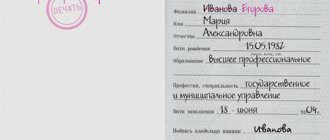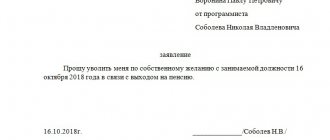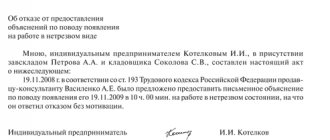A work book is a mandatory document when applying for a job.
However, a person who wants to get a job in a specific company/organization does not always provide the employer/HR inspector with a genuine work record.
For example, in order to hide the unpleasant facts of his work activity, a candidate for a certain position brings a new work record book. Or, for example, the document may contain “fake” data.
How to recognize a fake work book and what a person faces for using a fake document?
General information about the work book
The work book (LC) is an information carrier about the work experience of its owner and contains:
- Information about the citizen identifying his personality: full name, date of birth.
- Education received: name of educational institution, specialty, period of study.
- Carrying out labor activity (experience).
When hiring, the document should be submitted to the human resources department of the institution. It is stored for the duration of the employment agreement. Upon dismissal, it is issued to the employee.
Over the years, the type (form) of the document has undergone changes. All copies are valid.
The personnel employee responsible for storing and filling out work books must comply with the rules established by the legislator. In case of non-compliance with the established provisions, the personnel officer may be held accountable. Moreover, the type of liability will depend on the degree of violation.
It must be said that not every employee of the organization can fill out a work book. Only the manager, accountant and HR employee have such powers. Typically, large enterprises create a special department that deals exclusively with personnel records and personal affairs of company employees.
The purpose of falsifying a work record book
The use of false information involves several options for intentionally achieving a goal:
- registration of pension provision. We are talking about calculating the amount of payments. Entering additional information about increasing the insurance period helps to increase the size of the pension;
- falsifying a work book to get a job. Little or no experience becomes a “stumbling block” in finding a job for most young graduates. Employers often put forward requirements for candidates that are unique to the qualities of a highly qualified specialist with work experience. This circumstance is a prerequisite for committing illegal manipulations with one’s own work book;
- concealment of information regarding certain facts of work activity. The work book is a carrier of information about the previous places of work of its owner, and a record of reprimands or dismissal under an article may not be regarded from the best side by the new manager.
It happens that the owner is not aware of a problem with the legal validity of the document. Through the fault of the employer, a work book filled out improperly and purchased in the wrong place may indicate that it is damaged. The length of time the offense was committed does not matter.
Common mistakes
Error: The employee whose employment record was found to be fraudulent was immediately fired.
Comment: An employee can be fired for falsifying a work record book only after his guilt has been proven in court.
Error: The employer produced a duplicate work record book, which turned out to be fake when the employee was hired.
Comment: A duplicate cannot be issued, since the original work book contained unreliable entries.
How to do it
Previously, a document confirming work experience could be easily purchased. Many organizations were involved in its production. Sometimes employers required new employees to provide blank certificates. For unlawful actions, a person applied to an enterprise subject to reorganization.
There was no special control over personnel details during the procedure. Preserving the seal and continuing to use it was a way to earn extra money.
The same cannot be said about modern times, since special rules have been established for the acquisition and maintenance of a work book. The appearance has also undergone changes.
There are several ways to falsify a work record:
- Entering false information. This circumstance actually causes non-compliance with established standards. The situation involves providing false information about working for a specific employer;
- Fraud. Using false details, such as a seal.
These are the most common ways to forge a document.
The legislator provides for liability for the production of false documents (forgery), the extent of which depends on many factors.
A lenient attitude from law enforcement and judicial authorities can be achieved in case of proof of an offense due to negligence (carelessness). Lack of intent indicates non-involvement in the offense.
Presentation of false documentation during employment is a reason for early unilateral termination of the employment agreement. An important nuance in this case is the indisputable confirmation of the guilt of the owner of the documents.
We recommend you study! Follow the link:
Rules for certifying a copy of a work record book
Violation of the law caused by the unlawful acts of the previous employer exonerates the employee. In this case, a new work book is issued with information about work experience based on the collected supporting certificates (copies of documents from the archive, the Social Insurance Fund).
The decision to dismiss by the employer himself in a situation with the authenticity of documents without conducting a trial is considered unlawful. The employee has the right to contact representatives of regulatory authorities.
Responsibility for falsification
If a citizen took part in the creation or distribution of counterfeit documents, then the punishment will depend on the severity of the offense and the degree of involvement in the process. Thus, the production or circulation of counterfeit documents is punishable under Article 327 of the Criminal Code of the Russian Federation. The following types of punishment are possible:
- arrest for up to two years;
- restriction of freedom for up to two years;
- arrest for up to six months;
- forced labor for up to two years.
If official forgery occurs, the perpetrator is punished under Article 292 of the Criminal Code of the Russian Federation. We are talking about the introduction of knowingly false information into documents by an official, municipal or government employee.
Preventive measures may be as follows:
- compulsory work from 480 hours;
- a fine of up to 80 thousand rubles or in the amount of the income of the convicted person received within a period of up to 6 months;
- arrest up to 6 months;
- 2 years of imprisonment, forced labor or correctional labor.
Forgery of documents during employment or to receive a pension is equated to fraud and is punishable under Article 159 of the Criminal Code of the Russian Federation. The following types of punishment are possible:
- up to two years in prison or forced labor;
- fine up to 120 thousand rubles.
When an official commits fraudulent actions, the following consequences are possible:
- fine from 100 to 500 thousand rubles;
- forced labor for up to five years;
- restriction of freedom for up to two years;
- imprisonment for up to six months with a fine of up to 80 thousand rubles.
Fake or original
A work book is a document, a sample of which is established at the state level. The official form has certain security features and is characterized by security measures designed to be a significant difference from a fake.
Each employer (HR officer), in order to avoid a conflict situation, must have an idea of the characteristic features of the document and know how to verify the authenticity of the work record. A thorough study will allow you to identify the offense in time and contact the competent authorities.
During the hiring process of a new employee, the employer's responsibilities include checking for:
- Lack of literacy (logic) in records.
- Incompetence of the persons preparing the documentation.
- Presence of typos, blots (corrections), errors.
- Mechanical damage.
- Lack of required details (stamp, signature of the manager).
- Non-compliance with business rules.
The presence of one of these signs is a cause for concern. In this case, a more thorough check is necessary.
The following facts will help you identify a fake document:
- incorrect number of the state standard, its absence;
- The page numbers are not in order;
- color (font) mismatch;
- typographic variety;
- invalid entry.
Both the personnel officer or employer and the employee himself should pay attention to these details.
Basic verification rules
Most of the instructions indicating how to check a work record for authenticity are built according to a single algorithm. To begin with, we examine the formal features described above. Then the records themselves are analyzed, their compliance with accepted standards and regulations, the presence of blots, and the unsatisfactory appearance of the seal.
Any doubts that may arise are resolved by calling the organization where the employee allegedly worked. Before this, he must be notified of the inspection. This is done in writing with a mandatory signature from the citizen.
Indicators of number, series and size
This information is the best method in the authentication process. The number and series provide information about the year the document was issued.
| Year of issue | Number | Series | Color | Size(cm) | Number of pages |
| 1977 | On 10 pages - from 1 to 39 (one every four: 1, 5, 9, etc.) | AT – I, AT – II, AT – III, AT – IV, AT – V, AT – VI, We recommend you study! Follow the link: How to get a new work book if the old one is lost by the employer or employee AT – VII, AT – VIII, AT – IX | Red | 10*14 | 40 |
| 2003 | On 11 pages – 1, 3, 9, 15, 19, 23, 27, 31, 33, 37, 39 | AT – X, TK – I, TK – II, TK – III | Series – black, number – red | 8,8*12,5 | 44 |
The work book must meet the following appearance criteria:
- The cover of modern work books is made of hard material (vinyl, calico). Old copies are made of cardboard.
- Title. A page containing data that allows a person to be identified as an individual (full name, date of birth).
- Tabular form of pages. The title of the column requires entering the relevant information.
- Imprint of the coat of arms (USSR, Russian Federation) on the cover of the document.
On a document confirming work experience, certain methods of protection against counterfeiting are established - watermarks.
It should be taken into account that the old and new copies have a number of differences:
- on old samples there are wavy lines visible to the naked eye;
- copies from 2003 are distinguished by more intricate protection in the form of a multi-colored mesh and sign.
The pages of the TC must be numbered. The absence of sheets can be detected without much difficulty.
Numbering can be restored if the font and color scheme do not match.
Each official document contains information about the publisher, the location of which is usually on the last page (at the bottom).
The counterfeit identifier is the established record of the printing house:
- Gosznak 1954;
- MPF Goznak 2003.
You need to look for these signs on the last page of the book.
You can determine the reliability of the data in the technical documentation if you have:
- changes in the form established by law;
- obvious grammatical errors;
- violation of the order of the organization's seal when making an entry in a document.
As a rule, these are the main points by which a fake can be identified.
Due to the employee's fault
If inspection of the documents of an applicant for a position raises suspicions about their validity, the employer has the right to contact law enforcement agencies in order to confirm or refute this fact.
Employment on favorable terms pushes some people to falsify the data entered in the employment record. Proof of the illegality of the employee’s actions after being hired will become a legal reason for terminating the employment contract. Holding the subject liable also applies.
There is no legal basis for dismissal without due process. A person who has suffered from the actions of management has the right to appeal to regulatory authorities to restore justice.
It happens that a personnel officer commits violations in the process of drawing up and filling out the Labor Code, leading to the loss of legal force of the document:
- sloppy (smudged) seal impression (lack of it);
- ignoring accepted instructions for handling TC.
In this case, liability measures are not applied to the owner of the work. The employer is obliged to issue a new document (duplicate).
Working under a false name, as well as falsifying documents, is punishable.
Inaction of management in such a case can lead to dire consequences for both parties:
- The employee may in the future apply for confirmation of non-existent length of service. The employer's refusal will serve as the basis for opening legal proceedings.
- Reliability of the work book. We are talking about the real owner of the document, who may be on the list of deceased.
- “Slander” to the regulatory authorities from subordinates.
This is a minimal list of possible consequences of document falsification.
conclusions
Responsibility for using a fake work book rests with both the employer and the employee himself. It provides for fines and punishment in accordance with the Criminal Code of the Russian Federation, up to imprisonment.
Attention! If an employer discovers a counterfeit form, he is obliged to report it to law enforcement agencies. Based on the degree of guilt of the employee, a punishment will be imposed on him, or, if he is not guilty, the employer will have to issue a new document.
Sources
- https://buhproffi.ru/kadry/poddelka-trudovoy-knizhki-kakaya-otvetstvennost.html
- https://hr-portal.ru/article/trudovaya-knizhka-chem-opasny-lipovye-zapisi-dlya-stazha
- https://hr-portal.ru/article/est-li-otvetstvennost-za-poddelku-trudovoy-knizhki
- https://trudopravo.ru/narusheniya-i-vzyskaniya/poddelka-trudovoj-knizhki-otvetstvennost.html
- https://naim.guru/trudovaya-knijka/proverka.html
- https://trudinsp.ru/otvetstvennost-za-poddelku-trudovoj-knizhki.html
- https://ZnatokTruda.ru/trudovaja-knizhka/otvestvennost-za-poddelku/
- https://Inspectrum.su/konstitutsionnoe-pravo/poddelka-trudovoj-knizhki-sudebnaya-praktika.html
- https://urist.club/administrative/oformlenie-dokumentov/trudovaya-knizhka/otvetstvennost-za-poddelku.html
- https://rabotniky.com/poddelka-trudovoj-knizhki/
Procedure for detecting a counterfeit
If a fake TC is detected, you cannot remain idle. A number of activities are expected to be carried out:
- Refusal to hire or make an entry in the work book is not allowed.
- Find out the employee’s level of awareness of violations made in the Labor Code.
The nature of the following actions depends on the position of the worker.
Innocence dictates the need to contact the previous employer to correct the mistakes made or to issue a new book (duplicate).
Finding out the circumstances surrounding the employee’s participation in the fraud process facilitates reporting the crime to the competent authorities (labor inspectorate, police, prosecutor’s office). Dismissal is not allowed until a decision on guilt is made in court. This will be followed by termination of the employment contract under Article 81 of the Labor Code of the Russian Federation.
Date of completion
- How to indicate the date of completion on the title page of the work book: in words or in numbers?
– The legislation does not contain a clear answer to this question.
When filling out, you must adhere to the rules established by the Instructions approved by Decree of the Ministry of Labor of Russia dated October 10, 2003 No. 69 (clause 13 of the Rules approved by Decree of the Government of the Russian Federation dated April 16, 2003 No. 225). The specified Instruction contains the requirement that in all sections of work books the date and month are indicated in Arabic numerals - two-digit, and the year - four-digit (clause 1.1 of the Instruction, approved by Resolution of the Ministry of Labor of Russia dated October 10, 2003 No. 69). Thus, when filling out the title page in the “Date of completion” column, you can indicate the date in Arabic numerals, for example, 01/10/2012. At the same time, the Instructions deal specifically with the sections of the work book - it does not indicate how to reflect the date of completion on the title page. In practice, the date is entered as follows: the date and year are expressed in numbers, and the month in words. This is explained by the fact that the format of the work book itself (columns for the date) provides enough space for such writing.
Thus, in the absence of a clear order, both methods of filling out are allowed: both in numbers and in words. Any of the above options will not be an error.










